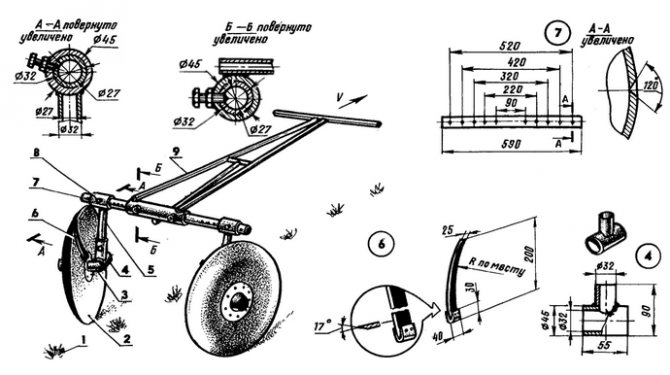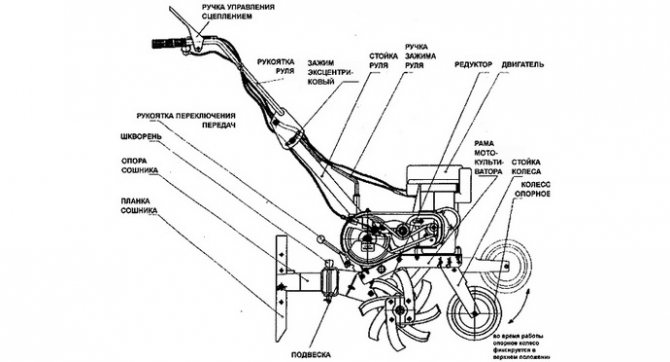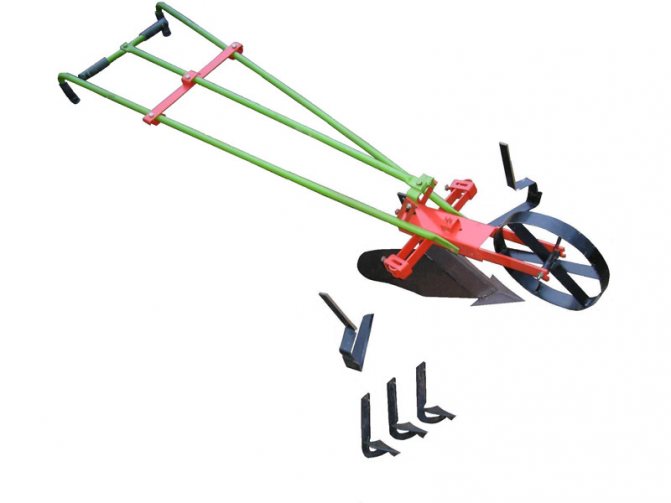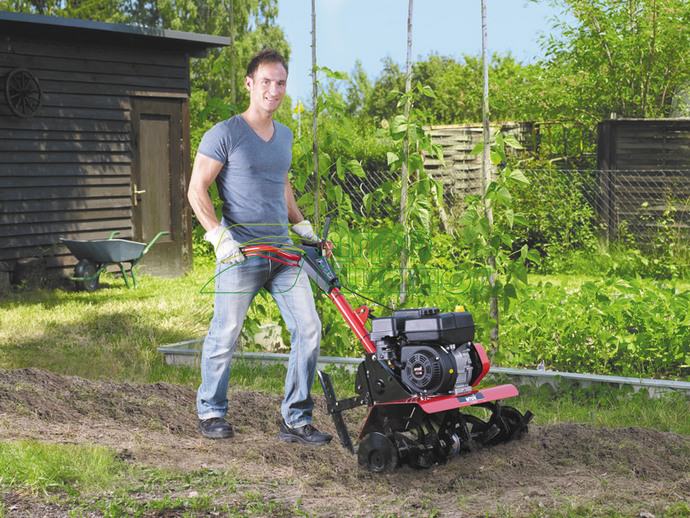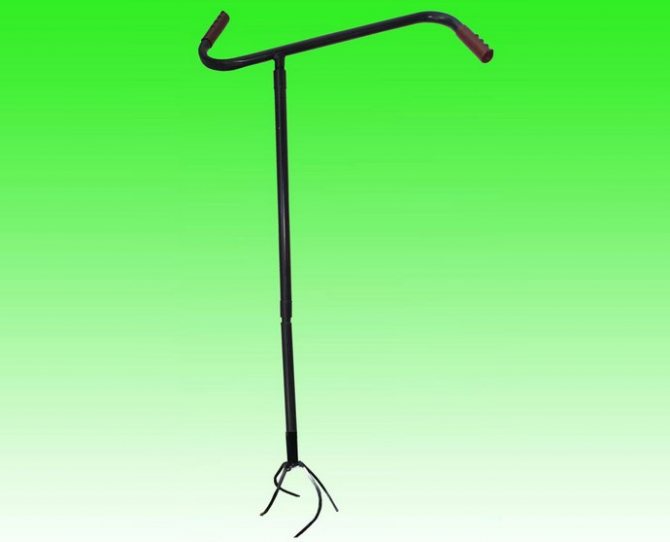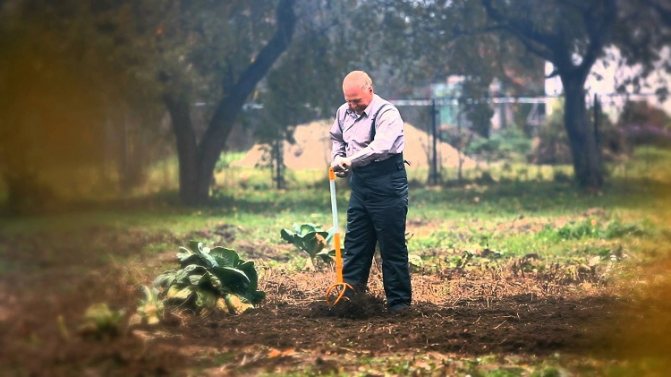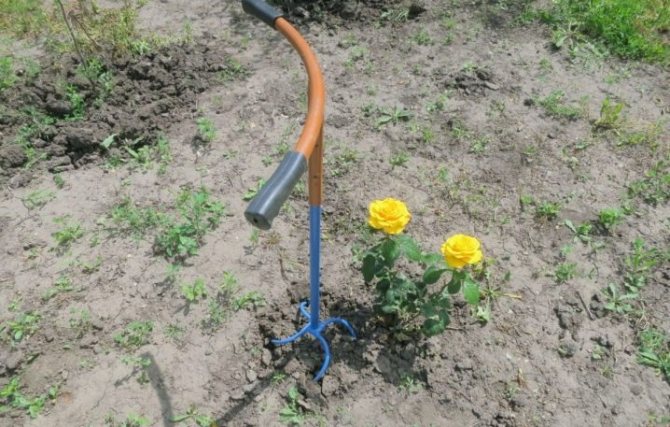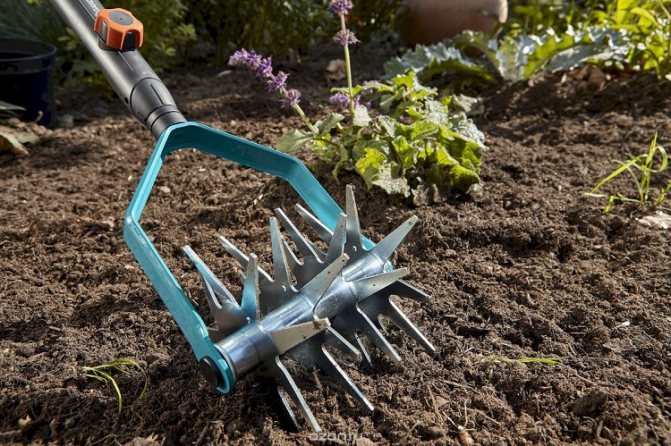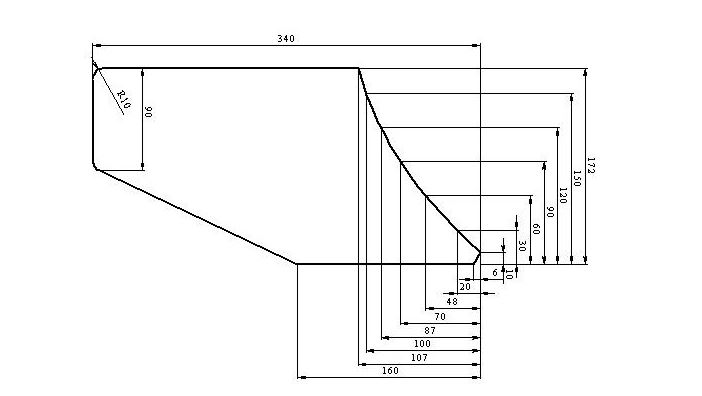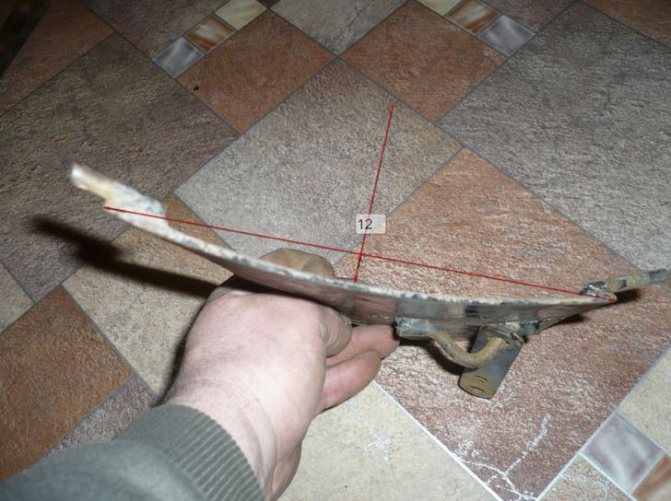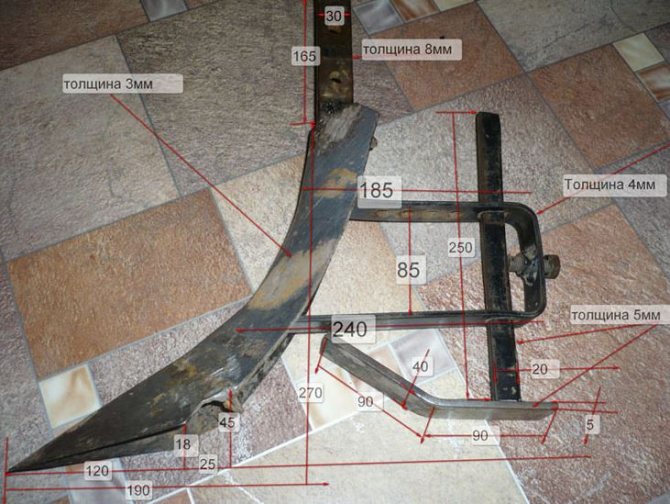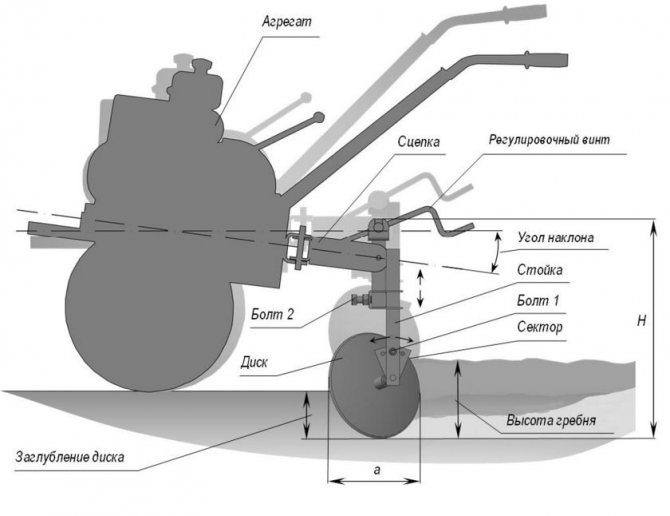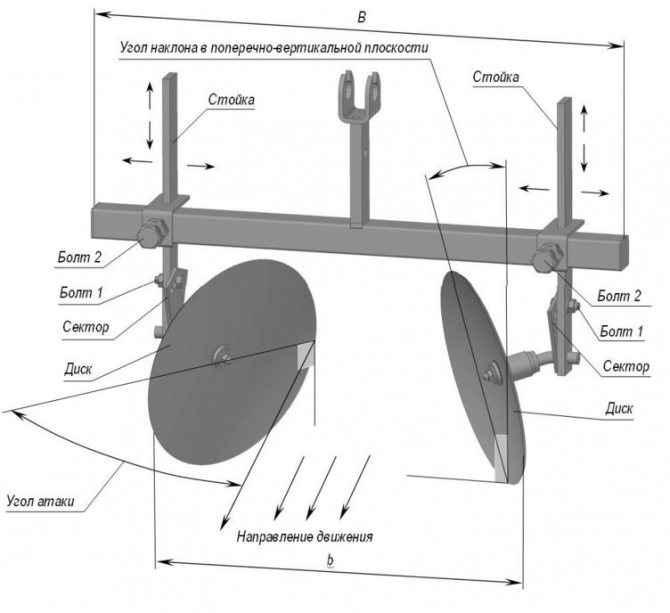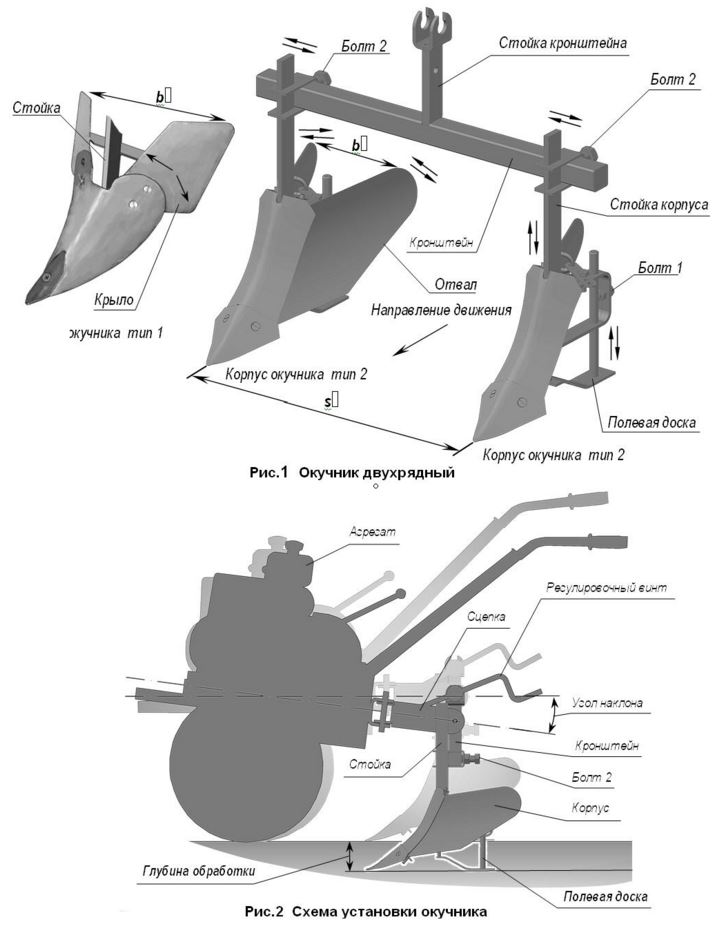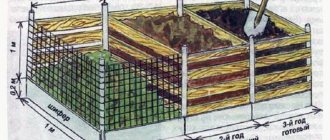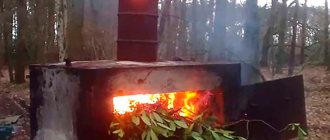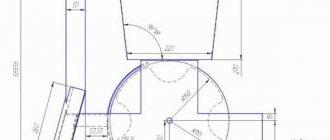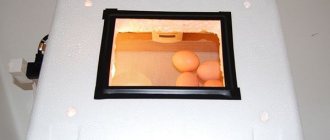Homemade hand cultivator options
Such an important function can be performed with a shovel.... But hard work will not pay off. The very efficiency of labor increases several times if you use mechanized means of tillage. A do-it-yourself manual plow can be made by any owner of a small plot of land. Special tools may require a welding machine.
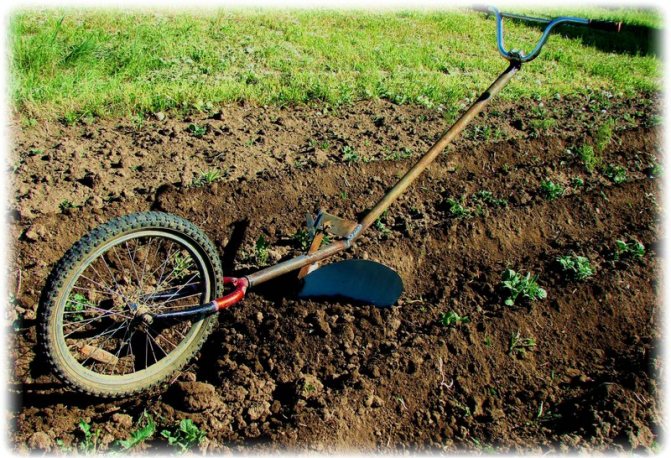
It should be noted that they began to cultivate the soil a long time ago... A few decades ago, at the height of the garden and suburban lifestyle, such a tool was very popular. It was both bought at factories and made independently.
Basically, the following types of tools are popular:
- Flat cutter. This is a tool that looks like a common hoe. He is his mechanized version.
- Rotary, or star. Such a plow works on the principle of alternately cutting the soil with knife-like stars.
- Cultivator "hedgehogs". It works on the principle of a rotary plow, but the soil is loosened not by knives, but by rods of steel, similar to a porcupine.
- Tornado. This tool looks like a regular pitchfork, but their rods are twisted in a spiral. Additional mechanical devices cannot be installed, it is only a hand tool.
The scope of the devices is the widest. Cultivators can perform the following tasks:
- loosen the earth, thereby saturating it with oxygen;
- cut rows for sowing crops and sprinkle them;
- rid plants from the influence of weeds, etc.;
- used in conjunction with a walk-behind tractor;
- break up lumps of soil and level the ground.
Pros and cons
The "Tornado" cultivator is a unique manual design that can increase labor efficiency several times. Despite the fact that the performance of the device is in many ways inferior to a motor cultivator, it is significantly superior to conventional garden tools. It is worth considering a few of the main advantages of such a cultivator.
- Ease of use and elimination of stress on the joints and spine. The unique design provides an even load on all muscle groups. During work, arms, legs, shoulders and abs are involved, but at the same time they do not strain. In addition, the instrument can be easily adjusted to any height due to its height adjustment, which results in increased ergonomics and reduced stress on the spine. The work is also simplified by the light weight of the device, which does not exceed 2 kg.
- Simplicity of design. The hand cultivator can be quickly assembled and disassembled. Once dismantled, it comes in three separate parts, making it easy to transport and store.
- Lack of energy consumption. Since the work is carried out at the expense of the owner's physical strength, the need for fuel and electricity is eliminated.
- High-quality tillage. During the loosening of the earth, its upper layers do not turn over, as happens with ordinary digging with a shovel. Due to this, the soil is better saturated with air and water, earthworms and beneficial microorganisms are preserved in it. This significantly improves soil management. In addition, the tool cleans the plantations from weeds well.He removes not only their upper part, but also turns out the roots.
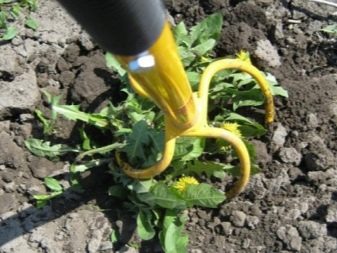

As for the shortcomings, there are practically none, with the exception that care must be taken when working with the cultivator. If the legs are not positioned correctly, the sharp teeth of the device can cause injury. Therefore, it is recommended to wear closed shoes before starting to cultivate the soil, and when assembling and dismantling the cultivator, its sharp part must be deepened into the ground.
Required materials and tools
In order to always be able to make some necessary products at the dacha, it is necessary to prepare the most popular materials in advance.
First you need to stock up on a lot of steel. It should be in every workshop. The number of different strips, profiles and pipes depends on how many necessary tools you can make with your own hands.
Welding will also be an irreplaceable tool in every household. With its help, you can quickly and reliably connect all parts of various designs. Bolts and nuts are used as an alternative to welding, but the reliability will not be comparable.
Many do not know where to start when assembling a hand-held cultivator with their own hands. Drawings are the first thing a novice owner should stock up on... And you also need to have the following set of tools and materials:
- Profile made of steel, pipes or fittings. This material will differ depending on the model selected.
- Wheel and fastening to it. Alternatively, take a bike frame.
- Handle. For this part, you can use both metal pipes and shovel handles.
- Welding. You can connect parts by welding, or you can use bolts, but it is desirable to have welding.
- Drill with a set of drills.
- Grinder with cut-off wheel.
Assembly instructions
The drawings will tell you no more than clear words about how to make a manual cultivator with your own hands, therefore, in order to follow the assembly procedure and not miss a few useful tips, you should carefully read all of the information below about how to make a manual weeding cultivator with your own hands. information.
For masters with a lot of experience, it may not seem new, but for those who have just started farming, a vegetable garden and a garden, such instructions will be more than helpful.
Here you will find several options for solving the problem of fast, cheap and effective weeding and cultivation of the site, bringing it to perfect condition, with fertile, well-breathing soil, free from weeds and pests.
Weeding cultivator
Weeding between rows is a very important process in gardening. It helps loosen the soil, remove weeds and allows beneficial plants to develop a good root system.
And in order to constantly monitor the cleanliness of the garden and the good condition of the soil, you need a manual cultivator for giving for weeding with your own hands.
The best choice, in terms of inventory model, is perfect manual cultivator hedgehog it is very simple to make it with your own hands, and the benefits will be no less than from a walk-behind tractor.
But, before using it, you should remember that this is a device to which you need to make efforts in order for it to work properly.
Also, when making such an inventory, it must be borne in mind that, due to its small size, large stresses will arise in some parts - they should be strengthened before these parts break.
The main risk point is the connection between the shank holder and the rest of the structure.
In order to make the main working part of the product, you will need a steel, non-rusty pipe of small diameter, about 22 centimeters long, a steel rod, about the same diameter as the hole in the pipe, and a slightly longer length - 23-24 centimeters, as well as sturdy steel pins or fittings.
On the pipe strictly perpendicular pins are welded on several pieces around the circumference, in rows with a distance of several centimeters. Just do not make them too long, if you did not grind them to a conical shape - then it will be more difficult to work with such a product.
Next, you need to make a bracket from a metal strip in such a way that it has a bend margin. Holes are made at its edges, and a fastener for the handle is welded to the end, on the other side. Next, you just need to insert the axle, with a hedgehog on it, into the holes and fix it with welding or cotter pins.
The product is now ready for use. If necessary, you can add another bracket to it, facing downwards, thus adding soil loosening to the weeding.
Tornado
One of the simplest agricultural implements is DIY hand tornado cultivator... It is very easy to make, just like a cultivator for a vegetable garden. In order to start making it, you first need to familiarize yourself with how it functions.
"Tornado" is a simple device that consists of three parts - a handle, a handle and a working part, which is the main one in this device.
The handle perpendicular to the handle is long and serves as a lever that facilitates the work of "twisting" weeds out of the ground, using the lower part of the product - long steel rods twisted in a spiral around the central axis.
Its principle of operation is similar to a corkscrew, but much larger.
With not intense pressure, the "Tornado" is driven into the ground where the weed is located, scrolls in place, moreover, the direction of rotation does not really matter, and rises up.
In this case, the weed, along with the entire root system removed, "unscrewed" from the ground. You can make this product yourself and it is not at all difficult to do it. There are two ways to craft it.
Using springy steel, you will make a completely new, very easy-to-use "Tornado". To do this, you need a tape of similar steel, with the following dimensions: length 0.5 meters, thickness 0.15 centimeters, width 2 centimeters. Next, you need to make a loop out of it, a downward spiral.
If there is only one loop in the product, then it needs to be given several turns, but if there are several, then a large number of turns can complicate the work - they must be short. The hinges are welded to the base from the pipe into which the handle will be inserted.
By introducing advanced milking technologies, labor productivity is increased, comfort for pets is ensured and production costs are reduced. Milking machines for cows - significant savings in your financial costs and time.
Motoblocks have long become a common thing for many rural farmers. Motoblock Beam is easy to operate and quite affordable.
Read also: Is it possible to solder aluminum with a soldering iron
With the help of snow blowers, you can easily clear the area from the snow that has fallen, without wasting energy and a lot of time. Here's everything about the wonderful Champion snow blower.
The ends of the curved tape should be sharpened into a long, stretched cone with a sharp end. Also, you can attach a long perpendicular handle to the handle, similar to the handle of the factory models.
Also, "Tornado" can make from old pitchfork... This will require, oddly enough, a pitchfork, a hammer and patience. With the help of a hammer, it is necessary to give the desired shape to the teeth of the forks, bending them with gentle blows.
Work must be done simultaneously in three planes, as if the teeth are immediately bent in one direction, it can be difficult to continue working.
Also, in order to make it easier for yourself, you can heat up the metal by welding, but it should not become too soft - the steel that is used for such equipment loses its properties with excessive heating, and can simply break under the blows of a hammer.
For the lever, in this case, you can use a pipe made of metal or plastic, which is attached with self-tapping screws. The optimal length of such a handle is approximately 50 centimeters.
This length is needed in order to work with any, even heavy soil, and to cope with a weed, which may have a branched and resistant root.
Flat cutter
Another useful inventory item is the manual cultivator flat cutter It is quite possible to make it with your own hands, although its design differs from the "Tornado" - it is somewhat more complicated. First of all, you need a bicycle, an old one is ideal, which no one uses anymore and one bicycle wheel.
It should not be too large, since such a wheel is inconvenient to use, it is better to take a medium and small one. Also, for the main working part of the plane cutter, the cutting part from a two-handed saw is perfect. Although, if there is a head from a cultivator, then this will be a simpler and more reliable option.
In order to make the frame of the product, you can take only a fork from a bicycle, with an attached wheel, to which you will need to attach handles, using welding or bolts. A crossbar is installed between the handles, to which a cultivator head or a plane cutter made of a saw is attached.
But this option, although easier to manufacture, is still not as reliable as a cultivator made from the main body of the bike frame.
In order to get a stronger and more reliable inventory, you need to turn the frame with the rear wheel fixed, and weld to it: on top - handles, at a convenient angle for you, below the cultivator knives, similar to the previous product. This design will be heavier, more stable and stronger.
Also, this design can be made more versatile, adapted to the use of different attachments, by making the cultivator mount on bolts. In work, such inventory will be much more convenient.
In addition, its use is the most productive of all the variations of cultivators presented here - it is extremely simple to use it, it moves continuously and practically independently, it is enough only press lightly on the hands, in order for the blade to enter the ground to the required depth.
Cultivator "Tornado"
It is not difficult to make such a cultivator. Its base can be made from a metal pipe. Steel rods must be welded to the end of the lower part of the pipe, thereby forming a square shape. After that, the rods are bent in a spiral direction, and the ends are sharpened.
Alternatively, you can use a bicycle handlebar as a lever, and instead of a metal handle, install a shovel shaft. This will significantly save your own energy while working.
Such an apparatus is intended for digging out various roots at great depths, for preparing holes for planting trees, etc. It can be used as electrophoresis for treating the soil with your own hands.
Garden auger application
- For drilling holes for planting large plants.
- For the installation of support pillars.
- When erecting fences, gates and gates.
The advantages of the new cultivator are ease of use, ease of assembly and excellent economy. The drill perfectly copes with any soil structure, has the function of adjusting the length of the handle (according to the user's height) and the depth of drilling. Super drill "Tornado" liked a huge number of gardeners - amateurs.
Judging by the reviews, this model is almost 4 times better lamellar drills and works 2.5 times better than augers. Please reasonable prices for this instrument - within a thousand rubles and a warranty period of more than 10 years.
The Tornado Garden Forks are convenient tool for carrying out work in the garden for carrying grass, hay, for processing heavy soils, during the planting period. The fairly low weight (slightly more than half a kilogram) and the presence of strong forged teeth contribute to the application of significant efforts when performing work. For greater resistance to loads, the fork handle was made of metal. For high-quality tillage the tool was equipped with the function of an overlay for the foot to help carry out the work process affordable and convenient way.
The advantages of a pitchfork are long service life, use in all weather conditions and at a reasonable price (about 800 rubles).
Snow shovel "Tornado" removes snow, sand, grain effortlessly and effortlessly on the lower back. The shovel weighs less than two kilograms. A special pipe was used for the manufacture of the cutting. with a small diameter, durable and lightweight in use. The scoop is made of plastic, which is not afraid of low temperatures and is quite durable. The shovel is designed to facilitate the work of the gardener-summer resident. She must be light and practical, comfortable and ergonomic (safe) - these are the qualities that the Tornado shovel is endowed with. A shovel in aesthetically designed beautiful packaging can be made an excellent inexpensive gift that will always help create a good mood and delight among gardeners.
All garden tools with the "Tornado" logo are used by summer residents and owners of private houses great popularity and in demand. The gardeners' reviews emphasize the ease and ease of use, low prices for the cultivator and its modifications. There are practically no negative comments. Special thanks go to the producers of this wonderful garden tool, low-income retirees who feed themselves the fruits of their hard work on land plots. And in this they are rendered invaluable assistance by the Tornado cultivator models, which are affordable for everyone.
How to make a flat cutter
Many are looking for a cultivator for weeding. Such a weeding apparatus can be made independently. A profile pipe made of metal or steel is used as the basis for the frame. This base needs to be done in 2 parts. You need to weld at an angle of 30 degrees. A wheel fork is welded to the frame, made of a steel tube or plate with a thickness of 3 millimeters. The wheel itself can be made independently or bought. The steering wheel must be made of 2 steel pipes fixed to the frame.
The horizontal part of the frame is an adapter for the cutting attachment. Then you need to mount a knife, which is made of steel tape 2-3 millimeters thick. Then the knives are sharpened. The sharpening angle can be changed or adjustable knives can be installed. If the farm has an old bicycle, then all spare parts can be taken from it. Due to the large diameter of the bicycle wheel, the ride becomes very light when working. The knife is made in the form of an inverted letter "P", or T-shaped. It should be noted that a T-shaped knife must be used very carefully between the rows, as there is a possibility of spoiling the crop.
A special type of flat cutter is the design with forks. Such an apparatus has several knives that are attached to a fork. It is made of steel rods, and they, in turn, are bent in a special way.
For such a device, you also need to make handmade knives with your own hands. Drawings of these devices are found in various thematic forums and blogs.
The design has a fairly easy move.Both a fragile girl and a small child can work with such a device. Loosening takes place at the highest level, but the roots of the weeds are practically not cut off. To do this, you need to choose what is more important: high-quality loosening or removal of pests from the soil.
Do-it-yourself hedgehogs for weeding potatoes with a walk-behind tractor
Hedgehogs for a walk-behind tractor have another significant advantage, namely, a simple design, which makes them extremely easy to make with your own hands. All that is required for this is the availability of the necessary equipment and materials at hand, as well as the study of detailed diagrams. Drawings will help you to assemble the equipment sequentially without making mistakes. It is extremely important that the dimensions of all parts are indicated in the diagram, otherwise the ripper will turn out to be disproportionate, and during operation it will always be brought in a certain direction.
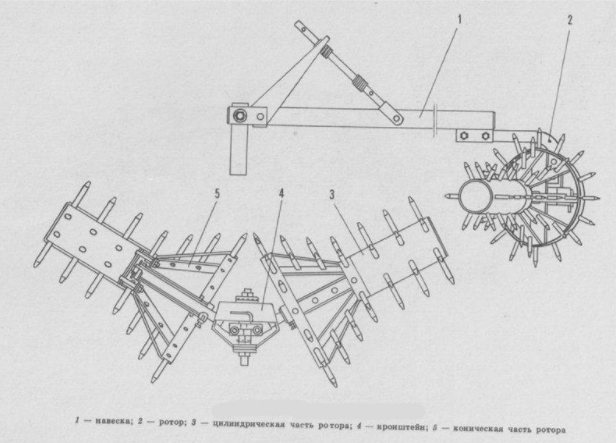

To assemble the device, you will need to prepare:
- 3 hardened steel discs - they must have the same diameter;
- steel pipe, up to 3 cm in diameter;
- hardened steel rods - the sharpest spikes for the equipment being manufactured should be cut from them;
- 2 identical guide wheels - they will help to reduce the load on the coupling mechanism of the walk-behind tractor;
- bracket for fastening wheels.
If it was not possible to find suitable identical discs, then instead of them you can use any of the same steel rings - this will serve as a kind of advantage, since the entire structure being created will be much easier, and will not trample the soil during work.
Both discs and rings must have a certain diameter - in most cases hedgehogs with discs with a diameter of 10, 17 or 24 cm are used for weeding potatoes.For working in larger areas, where there is more distance between the rows of planted potatoes, you can make hedgehogs with rings with a diameter of 30, 40 and 50 cm.
The sequence of actions when assembling hedgehogs for a walk-behind tractor is as follows:
- First you need to secure the discs or rings used. For this, the parts are mounted on the pipe by means of jumpers so that after installation they are located at an angle of 45 ⁰;
- Next, you need to securely weld the spikes. Before that, they should be cut from a prepared steel bar. Each spike should have a length of 10 to 14 cm - when choosing this parameter, the type of soil to be cultivated should be taken into account. Each of the discs must have the same number of spikes;
- To improve the quality of weeding, several long spikes can be welded to the pipe itself.
Do-it-yourself hedgehogs for weeding potatoes can be installed on a walk-behind tractor. If necessary, the position of the hedgehogs can be adjusted using the coupling mechanism of the walk-behind tractor.
Hand plow
Although such a device is called a plow, its direct purpose is reiterated. It does not have the classic properties of a plow. Even two people are not enough to work with such a tool. He is more of a classic cultivator. The device resembles a flat cutter, but a pulling handle is additionally installed.
For such a structure, one person is taken from the front, who plays the role of traction force. And the second, the operator, controls the process of cultivating the land. It is impossible to use such a device without a co-pilot.
It is important to note that such a tool is not suitable for plowing the soil for two reasons. The first is that a normal plow turns over layers of soil, and the device only loosens it. In addition, for normal plowing of the land, just one human strength is not enough.
Rotary, or star
Making such a device is not a difficult task. For the manufacture of the structure, you need 5-7 stars, which will serve as knives, strung on the axis. These knives can be either straight or curved to the sides.After cultivating the soil with such a tool, it is recommended to walk between the rows and with a plane cutter. A combination of two models is also possible, when first there are stars in the structure, and then the plane cutter is used for the final stage. Thus, you can significantly save the strength and energy of the worker. Since the stars perform the function of wheels in the structure, an additional axle is not needed.
It is quite difficult to work with such a tool, therefore only a physically prepared person can handle it. In such a garden structure, wheels of the same diameter can be installed instead of the stars. In this case, you will get a good weeding hiller.
Practical setting up a hiller on a walk-behind tractor
The theory of the operation of the hilling device is described in textbooks for summer residents in such detail - that even a person who is far from agriculture can figure out the settings. However, in practice, the saying “it was smooth on paper, but they forgot about the ravines!” Works.
The peculiarities of the soil, the current weather, the quality of sharpening of the hillers - this is far from the whole list of factors that affect the quality of plowing. Not to mention the characteristics of the walk-behind tractor. Therefore, before entering the garden, you need to walk the technique on the "virgin soil".
It is desirable that the characteristics of the soil be the same as on the cultivated soil. During the "work" you, firstly, will feel how the attachment behaves, and secondly, set the correct angles and depth of processing.
It is equally important to choose the correct plowing (hilling) speed. The relationship between speed and power when using disc nozzles was described above. The same applies to other devices. Sometimes an inferior homemade hiller, at the right speed, works wonders. And an expensive active baking powder simply scatters the earth on the sides.
For a detailed story about the settings of the potato tiller and its installation on the KADVI walk-behind tractor, see this video material.
Cultivator "Hedgehogs"
For the base, you need to prepare a powerful fork made of steel strip. In front of the tool there is a working axis with attachments. They need to be made from pieces of pipe, on which steel rods with pointed ends are welded. Actually, the name is from here.
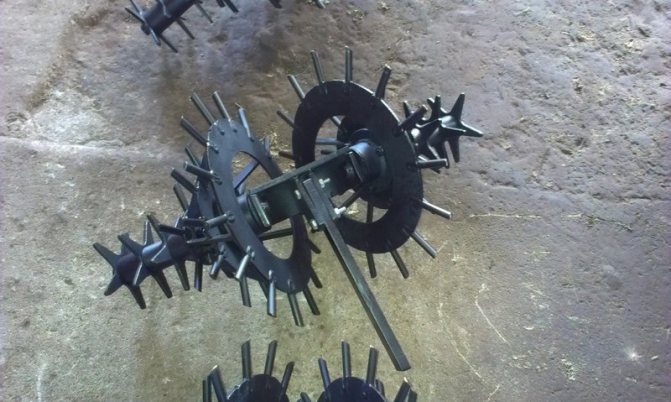

Loosening is carried out by lightly shaking the soil and piercing it, but the weeds remain in place, especially their roots. The main advantage of this type is the easy movement of the tool. Inter-row passage is virtually effortless.
As in the star model, in the hedgehog design, you can additionally install a flat cutter for the last stage of soil cultivation, with which all weeds are removed. For the handle, you can use both a shovel stick and a bicycle handlebar. This handlebar can be used in front of you and behind you.
For the first option, it is necessary to drive the hedgehog nozzle itself into the ground with its own weight. This process is quite time consuming. For the second case, you need to make the working part heavier. Nevertheless, it is much easier for them to work, despite the excess weight. In such work, you can heed the advice of parents. They are familiar with such tools personally. In the past, manual structures were very often used, since there were no mechanized means at all.
Features of the nozzle
Any attachment-cultivator for a trimmer significantly increases the weight of the entire device as an assembly (not less than 5 ... 6 kg). Therefore, long-term work with such a tool is not within the power of everyone. In the calculation, it is also necessary to introduce mechanical limitations on the power of the trimmer drive. If the engine is designed for a power of no more than 1500 W, then the cultivator can only process regularly loosened soil, or limit it to hilling breasts, potato bushes, etc.
Since the drive of the petrol trimmers is located behind the worker, and the drive rod is rather long, vibrations constantly occur during the cultivation process. Their size is determined by both the length of the rod and the varying load on the discs or cutters. These vibrations are transmitted through the shoulder strap to the user's hands, so it is not always convenient to operate the trimmer button and hold the canopy over a rather capacious unit. Therefore, long-term cultivation of the soil using a cultivator attachment is unsafe for health.
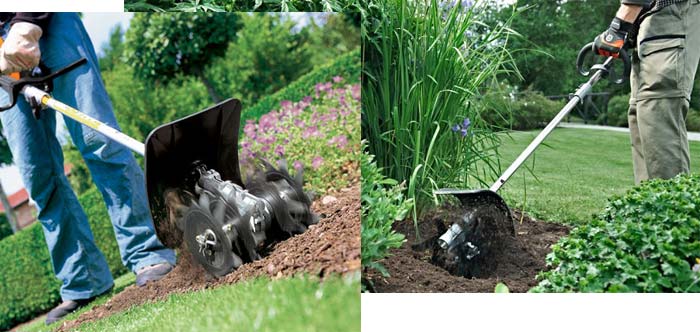

But not everything is so bad: the mobility of the petrol trimmer makes it easy to cultivate the soil between rows, and the absence of wheels on the mounted cultivator does not damage the plants in the beds.
The cultivator attachment “does not like” packed soil, and when it is first introduced into such soil, the bar is abruptly thrown away. Therefore, disc cultivators are equipped with a safety guard (tine cutters are more likely to bend than break, although in this case a low protective guard on the side of the legs would not hurt). The presence of the safety screen impairs the visibility of the cultivator.
Today I decided to talk about a fairly convenient tool in order not only to weed the garden, but also at the same time to leave the ground even and without large lumps. This is a manual cultivator "Poltava", you can, of course, see what it is:
I worked with this device quite recently, so weeds have not yet appeared (2-3 pcs per square meter is available and that's all), but at first there were of course a lot of them. Something we have modified here a little (for example, the wire stands for reliability and for spacer), however, this is not important. In fact, this is a very convenient thing for a gardener, because I do not like to get rid of weeds with my hands, hoes are also not very convenient, because firstly they leave behind an not entirely flat surface, and secondly they sprinkle dirt , and not only cut, but also one that was not noticed immediately (and after a couple of days it will appear again). This cultivator eliminates all these problems, of course, if you use it correctly. In order for weeds to be cut, he has such a plate in the shape of the letter "P" installed:
Read also: How to pluck a goose with an iron
The sharper you sharpen it, the better it will be to cut off all unnecessary (by the way, you need to sharpen it on both sides, since during the backward movement, the cultivator performs almost all the same functions as forward). As with all sharp devices, you need to be careful, I don't know why other users consider it dangerous, for example, a hoe has a much more opportunity to hurt you with something, and not only in inaction (when lying or hanging somewhere, as in our case ), but also during operation. Here, however, there is no danger, especially during work, since this cultivator does not reach about 1 meter at the moment of weeding. By the way, for the convenience of sharpening, the plate can still be removed, this is done quite simply, since it only holds due to its shape (stretch it slightly and it will be removed):
And in order to maintain a certain depth (preferably at least 1 centimeter), there is a roller in front of four peculiar "stars" that break large lumps of earth and turn them into something like sand.
If you weed everything well, then the weeds will not appear for about two weeks, and the soil will be soft and even "fluffy". Of course, this thing has its drawbacks, but of course there is no way without them, after all, there are not very many of them: 1) If the ground is solid, then it will be difficult to work with this device for the first time (I hope everything is clear with this. in 2-3 times the earth will acquire softness, I now have such a whole garden); 2) The standard knife plate quickly becomes blunt (we somehow have a complete staple staple quickly, because.sometimes pebbles come across, sometimes the ground is too hard, so they often sharpened. This is already another, cut according to the standard, from a harder metal and one sharpening is enough for the whole season, or maybe not for one); 3) It is impossible to work when the ground is damp or the weeds are higher (or longer) 20 centimeters (if it rained the day before, you will have to wait until it dries out, otherwise it immediately sticks to the plate and it no longer cuts anything off, because you cannot clean it every couple of meters And tall weeds wind up on the front "wheels" and they not only cease to perform their function, but also turn them with difficulty); 4) They didn’t think of putting the bearings on the front part (then it would be much easier to work with this device and large rubbish wouldn’t cause problems anymore. Of course I lubricate it regularly, but it doesn’t help much, because there is a lot of dust, and there it is in this case, it settles even more). Otherwise, I like this cultivator, because despite the fact that it is a little harder to work with it than with a hoe, the result of labor is much better and smoother, see for yourself:
In this state, the earth will be at least a week, only then small rubbish will begin to appear in places (we have it), and after 2-3 weeks it will need to be cut off again. If you follow the garden and weed with such a device a couple of times a month, then you won't even need to rake out the garbage, because the next day after weeding, only such a clean land will be visible and that's it. I don't know the price, because this cultivator was presented to us by our relatives. I will give the "Poltava" hand cultivator a good mark and, of course, recommend it to gardeners who like to keep their plot clean.
Cultivation is loosening the soil, which has already been processed earlier, with pruning of weeds and other plants harmful to the crop.
Cultivation helps to improve the water and air conditions of the soil, thereby increasing its fertility and the possibility of planting complex and demanding plants on it, such as, for example, a sunflower.
Important nuances when working
During the performance of any work in the workshop, it is necessary to comply with all safety measures. It is very important to protect your eyes when working with welding, regardless of its type.
When using arc welding, the danger can be carried not only by the light from the burning of the arc, but also by splintering steel at the site of the newly formed seam. Moreover, the seam can break off on its own and be thrown over a long distance.
Taping on a hot seam is also a bad idea, as the hardened steel can get into not only the eyes, but also behind the collar or hair. Therefore, these places need to be closed first.
When working with electric welding, it is necessary to have gloves and a protective helmet, since work takes place at high temperatures. Combining oxygen and oil should also be avoided, as this is an explosive mixture and a spark is not needed to detonate.
The production of a manual soil cultivator with your own hands will cost much less than its factory counterparts. The cost will be higher when the design includes both mechanized and additional tools and "gadgets".
Making inter-row homemade products, you can not only save money, but also get the opportunity to design it for personal needs. This will allow you to achieve maximum convenience when working with such a tool.
Therefore, even such simple products as a “hedgehog” or a bicycle cultivator can significantly reduce labor costs during work. This process will be unique and very convenient.
Almost all modern landowners are aware of what constitutes a hand cultivator. To simplify their work, summer residents use a variety of equipment - irrigation, sowing, harvesting, and devices designed to care for the land.The latter are considered one of the most important and difficult, because the soil needs regular heaving, loosening, harrowing, etc.
Rules for the operation of hedgehogs for a walk-behind tractor
In order for self-made hedgehogs on a walk-behind tractor to last as long as possible, you should adhere to certain rules during their operation.
The latter include:
- do not install homemade hedgehogs too close to the back of the walk-behind tractor - during operation, an unexpected blow may occur, which will bend not only the pipe of the device, but also damage the walk-behind tractor;
- try not to work with equipment in areas with a large number of large stones - as a result of this, the spikes on the hedgehogs quickly bend and become unusable;
- regularly clean the spines and axle of hedgehogs from the wound weeds - it is best to do this after each processed row;
- use hedgehogs on a walk-behind tractor mainly in dry weather - wet soil will contribute to the formation of corrosion on the spikes and pipe of hedgehogs;
- before each season, paint all structural details and treat them with an anti-corrosion compound;
- sharpen only the extreme lower parts of the thorns - if you sharpen too many of the parts, this will lead to cutting off the weeds instead of winding them on the discs;
- use only a grinder with the smallest abrasive wheels for sharpening;
- at the end of the season, homemade hedgehogs must be cleaned, treated with a car anti-corrosion agent and sent to storage in a dry room.
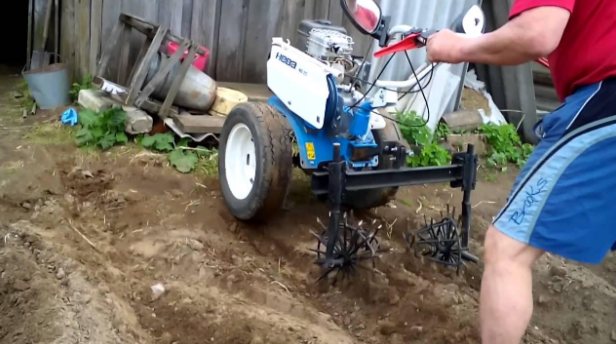

Compliance with all of the above rules will help maintain the effectiveness of homemade hedgehogs for a walk-behind tractor, as well as extend their service life.
The described procedure for the manufacture of hedgehogs is optimal for assembling a device that can be used to work with the Neva walk-behind tractor and agricultural machines produced by other well-known brands.
General description of the cultivator
In small areas or in hard-to-reach and very narrow places, large-sized equipment will not be able to pass, so a manual cultivator for a summer cottage can be very useful. This is the simplest and cheapest type of agricultural machinery. Such a cultivator allows you to perform almost any manipulation associated with soil cultivation.
Loosening, removing weeds, weeding, digging with the moon for seedlings and flowers, mixing fertilizers - it is a manual cultivator that can handle all these tasks. These devices are especially popular with gardeners, because they are very convenient to handle. greenhouses, flower beds, rose gardens, etc.... Although some craftsmen use hand-made homemade cultivators, there are a lot of tool models on sale today. To understand their diversity, you need to delve into this topic.
Rotary device type
The rotary cultivator makes it very easy to loosen soft soil. The design of such a tool includes a cutting shaft with fitted star-shaped discs. The more toothed parts are installed in the cultivator, the wider the gripping area of the device will be. The disc-type cultivator is placed on a comfortable handle that allows you not to bend over during work. It is very simple to use it: the device is placed vertically in the soil, the sprockets are located exactly between the rows, and an arc is located above the bed.
Accessories for planting potatoes by hand
Hand tools include a hand plow, markers and a hand cultivator.
A very handy device is the Vyatsky Plowman plow. Planting potatoes is done in this way. Furrow No. 1 is dug, tubers are laid in it. They begin to dig the second furrow, while digging in the first. Furrow No. 2 is used for fertilization. When digging the third furrow, the second is covered with earth. Tubers are re-placed in furrow no. 3. And the whole procedure is repeated.The row spacing with this planting is 60 cm.
Root remover and its features
This cultivator is equipped with a spiral-shaped bar with sharp teeth and a handle. When working, the tool cuts deep into the ground, without causing any damage to plantings.
For processing, the device must be placed vertically, slightly press and unfold the handle. The device will stick into the soil, and its rod will grab an earthen ball and cut the root of the weed plant, which can be easily pulled out. The advantage of root removers is that they do not harm the structure of the earth, in contrast to the processing of the site with a shovel. However, this device requires a lot of physical effort to use, so it is more suitable for people with strong hands.
What are the advantages of using hedgehogs for weeding?
The advantages of using hedgehogs on a walk-behind tractor are obvious to every farmer.
They allow you to:
- perform effective weeding of the area planted with potatoes - during operation, they do not cut the stems of the weeds, but wind them together with the root, which allows you to achieve the best result when processing the beds;
- loosen and huddle the soil, which will increase the amount of moisture, oxygen and heat received by plants;
- get rid of pests - hedgehogs on a walk-behind tractor effectively scare away ubiquitous rodents, and turn out harmful insects that feel comfortable and actively reproduce only with a layer of soil;
- help to level the soil layer on the planted bed and cultivate the bed.
Using hedgehogs on a walk-behind tractor, the site owner gets the opportunity to save his time and effort, which is very important when growing a large amount of potatoes on large areas.
Related article: Methods for harvesting potatoes: types of motoblocks and potato diggers
Ripper models
The ripper is a sturdy, multi-tine metal rod designed for weed control. On the top of the tool there is an arched handle for control. When starting to work with a manual ripper, you need to swing well and cut the device deep into the ground. After that, you need to turn the handle and pull it towards you.
One of the advantages of this device is the even distribution of the load during operation. The disadvantages include the impossibility of processing large areas. If weeds have grown very intensively on the territory, then the operation of such a device will be very ineffective, because it requires tremendous efforts. There is also a possibility of accidental damage to the rhizomes of cultivated plants.
When working on the site with a ripper, it is imperative to follow all safety rules, otherwise sharp teeth can cause serious injury. Sturdy and fully closed shoes must be worn before using the tool.
Potato diggers and other units
Any summer resident who grows potatoes every season is well aware of the features of a potato digger, because this tool is very useful for harvesting. If you dig up potato fruits with a shovel, you can get tired very quickly. A great alternative is the potato digger. This tool has a very simple design, which consists of a handle, a strong shaft and sharp teeth at the bottom. The height of the device can be adjusted, which makes this tool very convenient for any gardener.
There are special tools for greenhouse or indoor plants. They are characterized by short handles and compact dimensions. They allow you to prepare holes for planting bulbs of a wide variety of plants, loosen the soil next to flowers and remove weeds. They are very convenient and easy to use, because handling a small container requires almost no physical force.
Making a cultivator with your own hands
If you have the time and desire, then you can make a cultivator with your own hands. Many structures can be made from scrap materials, while others will require additional elements. One way or another, the cost of a homemade device will turn out to be much less.
For example, to create a compact tool, you can attach to an axis durable metal sprockets... After that, all that remains is to find a comfortable handle. In this case, the cutting parts must be sharpened properly. For another design, you can use an unnecessary bicycle frame by attaching iron bars, a glanders, a plow, or part of a broken cultivator to it. The handle can be made from metal pipes. After assembling the base, you need to fix the wheel on it, which should be of medium size.
There are other models of homemade tools, but they already require more thorough knowledge and skills in plumbing. In addition, many craftsmen manage to make gasoline and electric cultivators from "garage" funds.
Advantages and disadvantages of the tool
As a rule, farming involves physical work, which is why cultivators are popular for making it easier. Of the advantages of such a tool, the following can be noted:
- ease of use;
- no maintenance required (refueling, lubrication);
- neat processing;
- the ability to work in hard-to-reach and delicate areas (greenhouses, rose gardens, places between bushes and trees, flower beds).
The most basic disadvantages of the devices are:
- obsolescence;
- the need to change discs from time to time (in rotary cultivators);
- small performance indicators;
- physical effort is required;
- low efficiency on solid and virgin soil.
Hand cultivators must be used very carefully. Pressing too hard on the tool can damage the crop roots.
To care for a small area, it makes sense to purchase a hand cultivator. With the help of such a device, you can perform a wide range of work: plowing the land, cutting the beds, weeding, cultivating, etc. The machine is suitable for long, not very wide and even beds. It will be a good replacement for a gasoline or electric analogue.
Weeding potatoes with a walk-behind tractor
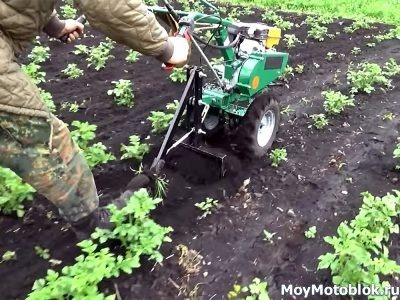

Here is a method of caring for root crops, known to a wide range of summer residents. The process requires compliance with certain features. Only by being guided by certain requirements, you can get a high-quality harvest of potatoes and other crops. The presented tips will be relevant for those who have little experience in growing such crops or prefer to use old-fashioned methods. Weeding potatoes with a walk-behind tractor will become much easier.
Related article: Potato yield per hectare in Russia and the world - analysis
Types of manual cultivators
The use of a manual cultivator is necessary if you need to cultivate flower beds, greenhouses, alpine slides, areas between bushes and trees in the country. By design, the device is for the garden and for indoor plants. Depending on the design features, the following options are distinguished:
- rotary;
- ripper;
- root remover;
- potato digger;
- flat cutter.
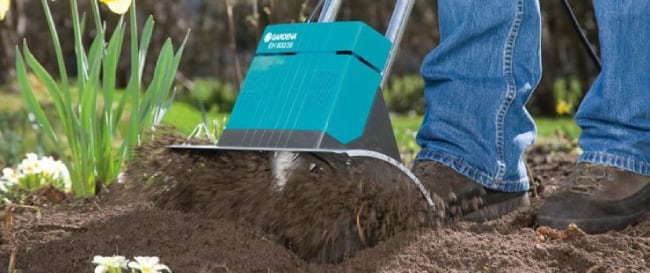

Hand cultivator at work
Manual cultivators for the garden have many advantages. These include:
- ease of use;
- affordable cost;
- small dimensions;
- light weight;
- no need for maintenance, i.e. lubrication, refueling;
- the accuracy of cutting weeds;
- the ability to process hard-to-reach and delicate places in the country;
- a wide range of work performed;
- a higher level of safety compared to motor and electrical appliances.
Manual units for giving and disadvantages are not without. Their disadvantages are:
- low productivity, so they are not suitable for tasks in large areas;
- obsolescence compared to modern self-propelled units;
- the need to replace discs in rotary structures;
- low efficiency on hard soils, virgin soil;
- the need to use physical force, so a lot of work may be required to process the site.
How to choose a manual cultivator
When buying or making a hand cultivator by yourself, attach the main importance to the choice of design. Helpful hints:
- If loosening of soft soils is required, then give preference to a rotary cultivator for summer cottages. It is good if the kit includes a weeder knife that cuts the grass and turns its roots out of the soil.
- Since hard soil is too tough for the rotary attachment, choose a hand-held cultivator-cultivator for cultivating it.
- If your site in the country is heavily overgrown, then you can put it in order with the help of a root remover. They can also loosen the soil.
- For pot and container soil, choose a small hand model with short handles. The narrow mini-cultivator is also suitable for loosening the soil on alpine slides.
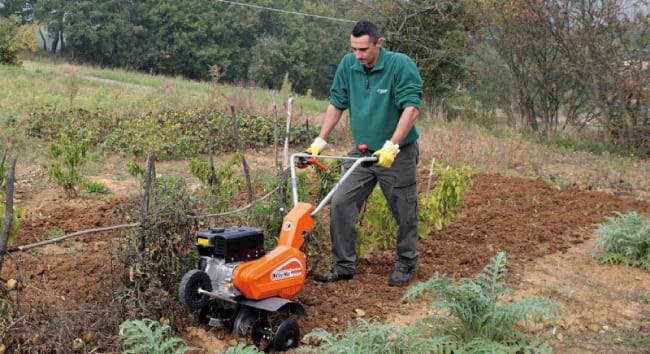

Hand cultivator application
Consider some other selection criteria. More about them:
- read the technical data sheet of the product;
- pay attention to the strength of the metal parts, the reliability of their connection points;
- Take the unit in your hands to try to adjust the length of the handle and make sure that it is easy and comfortable for you to hold the device in your hands;
- Estimate the weight of the structure so that it is not too heavy.
How to properly use the Tornado tool for soil cultivation
The Tornado hand cultivator is agricultural tool that is used to cultivate land. It significantly improves the quality and speed of work on land. Today such a tool cannot be found in the whole world. Only a couple of years ago, without a hoe and a shovel, there was nothing to do on the site. And today all garden tools for cultivating the land can be replaced by one Tornado cultivator. In this article, we will explain how this cultivator-ripper works.
Popular models
Before ordering a manual cultivator for a summer cottage, familiarize yourself and compare the characteristics of common models. Consider also their pros and cons. Popular hand cultivators:
- Gardena
| Price in rubles | Characteristics | pros | Minuses |
| 1889 | Type - star-shaped; length - 37.7 cm, weight - 0.865 kg, working width - 14 cm, material - steel, attachment for handle / shank - combisystem. | Convenient, effective, lightweight, easy to use. | No handle / shank included, more expensive than alternative options. |
- Tornado
| Price in rubles | Characteristics | pros | Minuses |
| 1299 | Type - root remover, weight - 2000 g, dimensions (packed) - 68x20x20 cm, loosens the soil to a depth of 20 cm. | It can loosen the soil of almost any density, remove small and large weeds, and can adjust the length of the boom. | Difficulty working on hard, trampled ground (requires a lot of effort), assembly may be difficult. |
- Assistant
| Price in rubles | Characteristics | pros | Minuses |
| 2479 | Includes 2 telescopic handles with adjustable length, handle height - 100-150 cm, teeth length - 28 cm, material - high carbon spring steel, folded dimensions - 58x100x10 cm, weight (packed) - 6960 g. | Crushes the ground to a depth of 25-28 cm, does not turn the ground, high processing speed. | Not suitable for digging up virgin lands, larger and more expensive than analogues. |
- Raco
| Price in rubles | Characteristics | pros | Minuses |
| 774 | Type - disc, purpose - cultivation, loosening, the main mechanism - discs in the shape of a star, material - steel, tool width - 14 cm, dimensions in the package - 13.5x34x15.5 cm, weight in the package - 690 g. | Affordable cost, relatively lightweight, easy to use, copes well with ground penetration. | The handle will have to be purchased separately, the knives are held in the fork with plastic plugs. |
- NPO Mekhinstrument
| Price in rubles | Characteristics | pros | Minuses |
| 929 | Type - rotary with a shank and a weeding knife, length - 147 cm, purpose - digging and leveling the soil for sowing, coating of the metal part - powder enamel, shank - wooden, dimensions in the package - 169x21x12 cm, weight in the package - 1860 g. | Reasonable cost, cuttings, loosens sandy soil well, cuts weeds. | The small width of the working part, the length of the cutting may not be optimal for all family members. |

